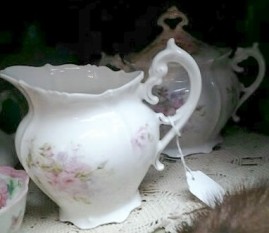I know, don’t make it a habit. Don’t eat off of them. Don’t drink from those gorgeous delicate Bavaria tea cups, and steer clear of those antique silver plate Demi spoons and put that antique Demitasse cup back as it was. You can appreciate it with your eyes, just not your taste buds. It was once called The Rich Man’s curse because only the rich fell ill with lead-poisoning from porcelain dishes they used everyday back in the Victorian and Edwardian eras.
It was at the antique store a while back where I discovered a demi-cup (not a bra), a Demitasse cup for drinking espresso coffee that was usually served after supper. Prices vary for antique dishes. Sometimes you might get lucky and find a near complete set of beautiful antique pristine dishes for dirt cheap.

And where did I find out about it being a ‘rich man’s curse’? I actually had to do a lot of research on this topic of antique porcelain dishes to find this out. Way back in the Victorian era and I’m going to include the Edwardians in this as well since high society tended to drink and eat from gold-painted and hand-painted porcelain dishes. Those crazed, dusty, often times, aged antique porcelain dishes that appear too fragile to even look at with an undecided glance are what I’m talking about. The kind of dishes that would have given our ancestors lead poisoning in accumulative doses over time.
However, the low income Victorians and even the Edwardians did not have disposable incomes to throw around in their time when these antique dishes were brand new, so they more than likely ate and drank from inferior table wear and/ or tin cups perhaps.
The most expensive antique porcelain I’ve come across recently was stamped R.S. Prussia, which I later discovered, is incredibly scarce to find in mint and flawless condition nowadays. Even at that, expect to pay upwards of $85 for one sugar container that has no signs of crazing under the glaze, no chips, no cracks, and no blemishes, etc. I’ve even scoured eBay for price comparisons and was shocked by the higher prices for similar near complete sets of antique R.S. Prussia porcelain. I assume the prices reflect the era in which they were made somewhere between 1847-1914. Well, when pigs fly or if I ever win the lottery, then I might upgrade to some exquisite antique R.S. Prussia China.
I’m a little wiser now than I was a year ago in terms of collecting antique porcelain dishes and what to look for. I know to avoid using those gold-rimmed tea cups, plates, saucers, bread plates, oh and tea tiles. Excuse me?
I believe they were once called ‘tea tiles’ back in the 1800’s and a pot of steeped tea would be placed on the tile like a trivet. I don’t know when the tea tile fell out of fashion. In fact, I had no idea tea tiles existed until just recently when I laid eyes on a set of Bavaria stamped antique dishes and discovered a few miscellaneous tea tiles placed in with other misc. antique dishes.
Do I plan to use these antique Bavaria dishes? No. They will be for display until I can do further research. And since they’re one of a kind I may display them in a inset book shelf. I scoured the net and came across some porcelain collectors’ blogs describing in length what to avoid when buying/collecting antique porcelain dishes and whether or not they’re safe for everyday use. The verdict on how safe they are is still very up in the air and there’s a lot of inconclusive answers floating around.
The very early makers of porcelain dishes may have maker’s stamps, or they might not have any markings. Transferware is nice. However, it didn’t call to me nor does it ‘fit’ in my Victorian-themed porcelain dishes. My heart and eyes were set on that particular ‘Bavaria’ porcelain set that included a covered butter dish with pink roses. And it was pristine white. Can’t beat that. There were no chips, no cracks, no crazing under the glaze, no stains, but one or two dark spots likely from when it was produced and trapped under the glaze.
And that wraps up my antique dishes blog post. I do apologize if I’m unable to blog as often as I used to on here, but will continue to do so as my new schedule permits. I will continue to answer all comments on here like always, but there might be a delay due to my work load. Please keep checking back for more interesting antiques I might happen across. As always thank you for commenting, re-blogging, sharing, tweeting and liking. I always appreciate it. 🙂



 Indeed, it called to me silently: four empty glass condiment containers that likely hadn’t seen table service since when? Probably since the late 1880’s. Curious as I was about it, I flipped the price tag over. $22 that’s more in my price range, and no, that doesn’t make me impractical, but I think in terms of what I feel an item should reflect price-wise.
Indeed, it called to me silently: four empty glass condiment containers that likely hadn’t seen table service since when? Probably since the late 1880’s. Curious as I was about it, I flipped the price tag over. $22 that’s more in my price range, and no, that doesn’t make me impractical, but I think in terms of what I feel an item should reflect price-wise.
You must be logged in to post a comment.